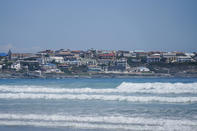Historical Sites
The town of Yzerfontein was established in the 1930s when the Katz family bought the Yzerfontein farm. The name means Iron Fountain in Dutch. The farm developed into a small harbour town known for its 16 mile beach.

Yzerfontein has various historical sites, including the old Fish House, which is the oldest building in town. It houses a number of unique historical photos of Yzerfontein.
There are also lime kilns in Yzerfontein, which are the only two remaining in South Africa. It was declared national monuments in 1980. The kilns are stacked with mussel shells and wood and a fire would be lit in the lower compartment of the kiln, while the shells would be placed on branches resting on the grid.
Air would be forced through the oven by billows. Quicklime would be collected from the pit below the kiln. The quicklime was used to white wash the walls of houses or as a cement between the bricks.
There are several private reserves in the Yzerfontein area, and visitors can spot animals such as bontebok, kudu, gemsbok and zebra. The Yzerfontein sal pan lies north of the town and was originally mined for salt and is currently mined for gypsum (a soft sulfate mineral used as fertilizer or the main component in various forms of plaster and wallboard).
 The West Coast is an easy drive from Cape Town and the Winelands, and all you need do is head onto the N7. Villages such as Paternoster, Lan...
The West Coast is an easy drive from Cape Town and the Winelands, and all you need do is head onto the N7. Villages such as Paternoster, Lan... If endless unspoilt beaches, the big blue ocean, small fishing boats, snoek and crayfish are your thing, then Yzerfontein will seem like a m...
If endless unspoilt beaches, the big blue ocean, small fishing boats, snoek and crayfish are your thing, then Yzerfontein will seem like a m...